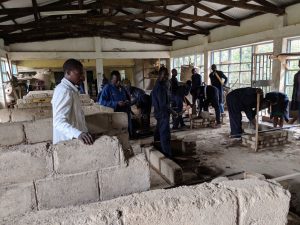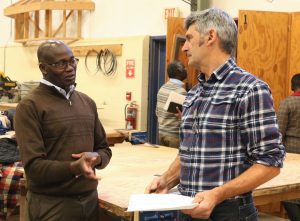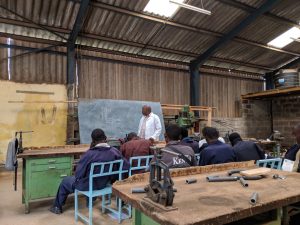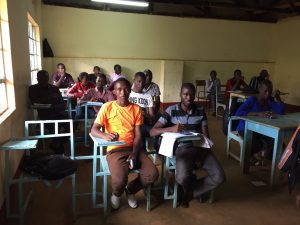3 Getting Started: Building a Teaching and Learning Centre

By John Gekonde, Kisii National Polytechnic
This chapter provides an overview of how to establish a TLC, as well as a number of areas to consider when just starting out.
STARTING A TLC: OPTIONS AND WAY FORWARD
Starting a TLC requires the management of the institution to properly conceptualize the idea before embarking on anything for this will determine its future success and sustainability. Even before a TLC is started, the institution must answer the following questions:
-
- Why do we need a TLC?
- Who will staff the TLC?
- What will be the administrative structure of the TLC?
- How will the staff be influenced to seek the services of a TLC?
But once institutions have determined that a TLC is right for them, there are different options for initiating a TLC.
| Option One | Option Two |
|---|---|
The best way out for starting a TLC in a Kenyan TVET institution may require inputs from an institution with an established TLC to mentor it, preferably called a development partner. The mentor can be from a developed country, given that it’s a fairly new concept in Kenya, or a developing country, though there are a few TLCs in Africa, too. |
In the absence of an established mentor, an institution can benchmark locally or abroad or even do ‘online benchmarking’ and borrow the best practices that can be adopted to start the TLC. Though this may be a tall order given that the TLC concept is new to the institution. However, whether with or without a mentor, online benchmarking will enrich the institutions seeking to set up a TLC. |

For the case of the Kisii National Polytechnic (Kisii NP]) it is TLC being mentored by Vancouver Island University (VIU) from British Columbia in Canada, and the mentorship involves the provision of a subject matter expert (SME) or consultant and funding of equipment for the TLC.
HISTORY OF THE TLC OF THE KISII NATIONAL POLYTECHNIC, KENYA

The initiation of the TLC has its roots in the 2017 study trip to Canada. Establishing a TLC in the Kisii NP was a recommendation contained in a report written by the Kenya Education for Employment Program (KEFEP) Lead, Mr. John H. Gekonde. This recommendation was made in November, 2021 following a study tour of Canada by the Kisii NP’s KEFEP project team led the then Principal, Mr. Athanas Mokaya. The study trip involved the Kisii team visiting VIU, the Canadian partner in the KEFEP project. The recommendation was endorsed by the KNP Governing Council.
The idea of establishing the TLC was incorporated into the Kisii NP’s Strategic Plan (2018-2023) by the KEFEP Lead, Mr. Gekonde, but did not take off due to lack of capacity. To that end, on April 26, 2019, the KEFEP Lead wrote an email to Vancouver Island University (VIU) to help set up the facility. This subsequently led to the arrangement for training of personnel to run the TLC.
In June, 2019 five trainers who attended a CBET training from Selkirk College (BC, Canada) were selected and trained as TLC champions in Kisumu National Polytechnic alongside those from Kisumu and Sigalagala National Polytechnics. The trainers were John H. Gekonde, Benjamin Ongoro, Geoffrey Nyachiro, Shem Kereu and Caroline Masara. The training was facilitated by Selkirk College under the auspices of KEFEP. The champions were to eventually run the CBET resource center.

In October, 2019 the Kisii NP Principal, Mr. Nyariki, accompanied by Mr. Gekonde to VIU and among the key agenda was to re-visit and strengthen the idea of establishing a TLC at KNP by consolidating the gains made so far. Following this visit, in February 2020, VIU sent Dr. Kathleen Bortolin to Kisii NP to bring the TLC to its feet by conducting further training of the TLC champions and conducting strategic planning sessions to design a pathway for TLC development. At the conclusion of that trip, Dr. Bortolin along with TLC champions facilitated a session for key HoDs and administrators to sensitize them to the TLC. The TLC at KNP had officially started. Since then, the TLC at KNP has had a dedicated staff member, Caroline Masara, who organizes the running of the TLC, liaises with various HoDs and other administrators, and facilitates many of the workshops, sessions, and consultations the TLC is responsible for.
Quick Reference: Steps require to be undertaken to start a TLC
- Choose a group of TLC champions with a Lead to spearhead the establishment of a TLC in consultation with the institutional management.
- The TLC Lead/team seeks approval from the institutional management to start a TLC.
- Decide which administrative office where the TLC will be domiciled. For the case of the Kisii National Polytechnic, it’s under the Deputy Principal Academic.
- Write a proposal to be shared with the development partner [mentor] so as to agree on how to start the TLC, the role of the mentor, the role of the mentee, staffing issues, future sustainability, etc.
- Draft documents to operationalize the functioning of the TLC] particularly the TLC policy, service charter, and staffing policy.
- Look for the right office space that is conducive to starting a TLC with the right furniture and furnishings.
- Conduct a training needs analysis for capacity building of the TLC staff and faculty.
- The TLC Lead/team draws a program of action and deliverables for the first few months or years in consultation with the mentor.
- Conducting the marketing/buy-in of the TLC among the faculty.
- Launch your TLC
WRITING A VISION AND MISSION STATEMENT
Vision and mission statements are very crucial in determining the direction the TLC will take, why undertake such a move, the pace at which it will move, and with who, and will also influence the level of motivation of stakeholders. Creating vision and mission statements requires a consultative forum and therefore it must be an inclusive process. The vision and mission statements will subsequently determine the creation of other statements such as the mandate and core values and also the drafting of the plan of the TLC. Some questions to consider when writing your vision and mission statement include:
- Who are your institutional champions/TLC leads who understand what a TLC is to spearhead its establishment? Will they be willing to support the development of a TLC?
- How will you approach management to inform them of the value of starting a TLC at your institution?
- What are the budget implications of establishing the TLC? Have you prepared a possible budget to show to administration?
- Do you have a TLC mentor institution? If not, can you connect with one?
- What would be a possible administrative structure of the TLC, e.g. should it have an HoD or Director? How many deputies if any?
- How will you network with other departments in the institution as well as outside the institution?
- How will you procure equipment and furnishings required for effective operations of the TLC?
- What service delivery model will you use? How and when the faculty be accessing services and from who, e.g. one-on-one consultations, group consultations, workshops, etc.
STAFFING A TLC: WHO WILL STAFF IT?
Quick Reference: How to staff a TVET TLC
When thinking about the staffing of the TLC there’s a need to design the structure in terms of:
- Set criteria for selection regarding professional and personal characteristics
- Consider staff cadre (hierarchy of staffing levels, subject matter specialists, and departmental representatives)
- Consider the number of staff required (tip: start small and scale up as your go)
- Determine budget requirements of the staff (salaries and allowances).
- Consider the impact of transfers. The Kisii NP model is having a college employee not liable to transfers in a team of public service trainers who are liable to transfers, even without notice.
Criteria for Selecting the TLC Staff
There are actually many criteria for selecting TLC staff, some of the common ones are listed below.
a) Skill requirements/specialization of the staff to run the TLC.
b) Qualifications of the staff: should they be trained teachers or not? The Kenyan situation may require one to be a trained teacher/professional teacher.
c) Experience of the staff.
d) Attendance in past training on CBET/methodology: only attendees stand chance.
e) Departmental representation across one per department.
f) Gender consideration based on the 1/3 rule.
g) Having passion for work.
h) Staff who can perform and hence are committed.
i) Self-driven trainers.
j) Patriotic trainers/no vested interests.
k) Ability to work in a team.
l) Great interpersonal skills.
3.6 STRATEGIC PLANNING AND DELIVERABLES:
a) What activities should be done/objectives and targets?
b) What are the outcomes?
c) Who is to do what (human resource requirement).
d) Time spans/timelines available/how long and by when? E.g. what ought to be done in the first 3 months, 6 months, 12 months, etc.?
e) Measuring outcomes (monitoring and evaluation)
f) Reporting of TLC activities.
g) Doing follow-ups and taking corrective measures
h) Staff responsibilities/facilitators of activities
i) Taking into consideration other programs in the institution.
j) Methods of marketing/buy-in.
Overview of TLC Development Training (February 2020)
by Dr. Kathleen Bortolin
Introduction

From February 10, 2020, until February 21 (10 days), the Teaching and Learning Centre (TLC) team from Kisii National Polytechnic (KNP) engaged in training and capacity building to support their efforts in opening their first TLC, a goal they have been working toward since 2017. The intention to start a TLC was inspired in part by a 2017 trip to Vancouver Island University (VIU) under the KEFEP program. At that time, John Gekonde, a key stakeholder behind the creation of KNP’s TLC, met with VIU’s CIEL and then-director, Liesel Knaack. It was during that meeting John decided that a TLC at KNP could support a broad methodological shift related to CBET.

Hearing about this opportunity from Darrell Harvey, I decided to apply for a Global Engagement Grant to create and deliver a training program to support KNP’s TLC team. I was awarded the grant and used my VIUFA PD time to take 10 days to travel to Kisii and engage the team in training. The training schedule and content were developed prior to my departure from VIU in consultation with KNP stakeholders, VIU colleagues involved in the KEFEP project, and my own ideas. What follows is an overview of the training, followed by a more detailed description and reflection of the ten days.
KNP TLC Training Team consisted of HoDs (KEFEP and TLC); a TLC coordinator and numerous CBET Champions.
Getting started at KNP : An example of Early Capacity Building at TVET TLC:
- Started with an introduction to our work and a general discussion about TLCs. This helped champions discuss their understanding of TLCs and the goals they wanted to achieve by developing one. This discussion supported the group in working toward a shared vision for the TLC.
- Facilitated a strategic planning session with TLC champions to get more specific about what the goals of the TLC were in the first year, and creating a pathway with clear, articulated steps to achieve those goals.
- Delivered capacity building workshops to TLC champions on a variety of pedagogical approaches including engaging students in the classroom; how to design a workshop; effective summative assessment; using formative assessment in the classroom; group work in the classroom, the Scholarship of Teaching and Learning (SoTL)
- Reviewed TLC Wishlist and created a committee to source items and find quotations to submit to partner institutions for procurement
- Discussed how to market a TLC: pamphlet, website, social media and HoD meeting
- Planned and participated The soft launch: Introducing the TLC to key KNP stakeholders: meeting and open forum.
STAKEHOLDER BUY-IN AND MARKETING OF THE TLC
Initially, and as you go along, there will be a need to come up with strategies to attract faculty to the TLC given that it is voluntary-based. There are a few ways to do this.
Firstly, TLCs should have a meeting with all Heads of Departments [HODs] to raise their awareness to the existence of a TLC, and the services it provides. HoDs will be a key relationship to TLCs and their buy-in will contribute to the success of a TLC. In fact, many department-specific requests for TLC support will come from HoDs if they understand and respect the work of TLCs. For this reason, TLC staff will have to create ways to stay connected, and in good relationship with HoDs.
Next, TLC staff will have to find ways to connect with trainers in all departments, and in the process encourage trainers to become “friends of the TLC.” Initially, TLC staff may have to go staff meetings and other events on campus in order to start raising awareness. Launch activities for faculty members are also encouraged. These sessions should align with the needs and interests of trainers and add value to them as educators, while also functioning as marketing for the TLC. For this reasons, these sessions must be high impact (tip: your best sessions!)
TLCs should also have an institutional webpage that includes information about the TLC, upcoming sessions, services offered and if possible, resources to support trainers.
NEEDS ANALYSIS AND DATA COLLECTION
A needs analysis will have to be done at two levels: one to determine the feasibility of establishing a TLC and another one being a TNA [training needs analysis] for the capacity building of faculty.
ANALYSIS NEEDED:
The TLC team/Lead ought to carry out a faculty TNA to determine the following:
a) Skill gaps among trainers that the TLC will fill before starting to train.
b) The most appropriate method of delivering training and TLC services.
c) Determine the attitudes and perceptions of trainers towards the TLC and the best way to counter biases or misconceptions.
d) To prioritize TLC service delivery/training program.
e) Enable in determining the specialists/facilitators to use in training.
For the case of the Kisii NP, a needs assessment was done focused on what the TLC should be doing and getting the opinions, facts, and misconceptions of the trainers about the TLC by directly interacting with them. Both types of trainers were involved, i.e. targeting those with teacher-training backgrounds and those without, based on the inclusive criterion.

Questionnaires, one-on-one interviews, and instructor feedback evaluation forms can be used to collect data about the TLC. The correct data assists in drafting the strategic plan, deliverables, policy document, and service charter. The needs assessment should be done during the conceptualization phase and training phase after establishment. This also provids a glimpse of frequently asked questions about the TLC as well as the creation of templates for use in the TLC.
FREQUENTLY ASKED QUESTIONS [FAQS] ABOUT A TLC
Q1. What is the difference between a TLC and teacher training college ?
A TLC basically is meant to give trainers both new and old the methodology for improved training at the institutional level and does not give certification for employment whereas a TTC provides training that leads to certification for employment. A TLC usually provides one-on-one or group-focused service delivery once or for a short time but a TTC provides long-duration training. A TLC serves faculty within an institution as a curriculum support center or teacher resource center. A TLC is demand-driven whereby trainers of an institution voluntarily seek its services whereas in a TTC attending training is compulsory. The TLC basically is to polish up one in teaching methodologies for those who have been trained while giving the basics to newly recruited trainers who don’t have a background in pedagogy before they can proceed to a TTC for more comprehensive training if need be whereas a TTC offers more comprehensive training in terms of content and variety of content. A TLC basically focuses on methodology and class delivery/instruction only and other issues related to that.
In a nutshell, a TLC is a teacher’s resource center at the institution or workstation that offers professional development services to trainers -helps them in improving their teaching and professional careers. It supports the implementation of institution-wide strategies and priorities leading to the adoption of modern teaching methods, discussions, and institutional changes in teaching practices. Hence, it leads and manages the provision of professional teaching-learning and developing individual and team performance among trainers. TLCs are unique to each and every institution and are basically found in tertiary/post-secondary institutions. And, finally, TLCs do not replace the role of a teacher-training college [TTC] –may build on the foundations of a TTC but narrows themselves down to pedagogical practices/teaching methodologies.
Q2: If am a trained/experienced teacher, do I need services of a TLC?
Once a motor vehicle leaves a factory it is brand new, shiny, stylish at the time, and stable, too. However, as time goes by and in due course of use it will require buffing, regular cleaning, servicing, and even modification due to changes in technology. In a similar way, a trained teacher will from time to time require polishing up, exposure to new methodologies, and exposure to technologies, among other things, to make him/her a better teacher all the time. It is the TLC that will carry out these roles after leaving the teacher training college.
teaching and learning centre
Kenya Education for Employment Program
Competency Based Education and Training
Vancouver Island University
Kisii National Polytechnic
Centre For Innovation and Excellence in Learning
Kisii National Polytechnic
Vancouver Island University Faculty Association
Professional Development
Heads of Departments
training needs analysis
teacher training college

